Guest Editorial Series by Ernest A. Canning
 How does one explain it?
How does one explain it?
The Eric Holder Department of Justice (DOJ) is faced with massive banking and Wall Street fraud that nearly brought the world's economic system to its knees, yet no bankers are prosecuted. It is confronted by environmental crimes that have poisoned our air, water and even the food we eat, yet, for the most part, those crimes go unpunished. It has its hands full fending off voter suppression laws concocted by a billionaire-funded, subversive organization, which is also responsible for deadly "stand your ground" laws and an assault on the right of citizens to engage in collective bargaining.
Yet, the DOJ and the Drug Enforcement Agency (DEA) make it a priority to target California medical marijuana dispensaries and to raid Oaksterdam University, a school founded by Richard Lee, a legalization activist who offers training in the cultivation and use of medical marijuana. It does so even though, in 1996, CA voters, by a wide margin, passed an initiative that "allows patients with a valid doctor's recommendation...to possess and cultivate marijuana for personal medical use." The raids were also made against the backdrop of polls showing that a majority of Americans support legalization of marijuana.
In this three-part series, we will advance the hypothesis that this seemingly irrational obsession with busting medicinal marijuana dispensaries and fending off legalization of even the most innocuous of drugs, Cannabis, can only be understood in the context of U.S. Empire and the economics of the Prison Industrial Complex.
In this first part of the series, we examine both historical and recent links between the CIA and the illicit drug trade. We touch upon the extent to which the so-called 'War on Drugs' has been used as cover for the CIA's covert import of narcotics, both into the U.S. and other nations, in order to fund the mischief the Agency engages in on behalf of U.S. Empire. That operation, evidence strongly suggests, continues to this day.
At the core of that hypothesis is the question as to whether an end to the phony 'War on Drugs' and its replacement by controlled legalization, taxation and medical, educational and psychological assistance in avoiding substance abuse would cut off a key, illicit source of covert CIA funding...
Covert U.S. drug trafficking then and now
As we noted in Part III of our 2009 special series on the long and storied history of torture by American agencies, "History of CIA Torture: Unraveling the Web of Deceit," torture is but one of the liberally used techniques, over the years, employed to help control populations in the U.S. Corporate Empire's forward march. Drug trafficking has long been used by the CIA to both control and fund its projects.
In Prelude to Terror: the Rogue CIA and The Legacy of America's Private Intelligence Network, Joseph Trento traces the CIA's direct involvement back to 1949 when the CIA shipped weapons to remnants of the Nationalist Chinese army in Burma, returning with shipments of heroin to Taiwan, Bangkok, and Saigon. In 1966 the CIA's station chief in Laos decided to ship heroin home as "a means of financing operations without having to depend upon Congressional approval and funding." By 1967, Dover Air Force base became a transit for CIA heroin shipped inside the body bags of members of the US armed forces killed in Vietnam. In 1968, the CIA's principle customer, Mafioso Santo Trafficante, Jr., took control of all the large Saigon nightclubs that catered to U.S. servicemen. Trafficante would then do his bit to "support the troops" by selling them heroin on the cheap.
Trento's account is similar to that provided by Prof. Alfred McCoy in The Politics of Heroin: CIA Complicity in the Global Drug Trade, which documents CIA alliances with illegal drug production and distribution that he contends had been an integral part of the agency’s efforts to maintain US power abroad. His contention is confirmed by John Stockwell, a former CIA agent, in a videotaped interview and by Michael Levine, a 25-year veteran DEA undercover agent.
At the outset of a 1991 interview, Paul DeRienzo observed that Levine quit the DEA in 1989 and then published, Deep Cover: The Inside Story of How DEA Infighting, Incompetence and Subterfuge Lost Us the Biggest Battle of the Drug War. DeRienzo described the book as a "chilling story of treachery by members of his own agency, and the CIA, men Levine calls the 'suits' who he says use the War on Drugs as a cynical cover for covert foreign policy adventure."
In the interview, Levine recounts that he first ran into CIA interference while working uncover in Bangkok, Thailand in 1971. He was suddenly pulled off a case in which he was going to expose Chinese drug dealers who were selling heroin to American GI's in Vietnam and "putting the heroin in dead bodies of GI's killed in Vietnam." He was told by his higher-ups at the time "there are other priorities."
In Cocaine Politics: Drugs, Armies, and the CIA in Central America (1991), P.D. Scott & J. Marshall expose the CIA’s involvement in drug smuggling, gun running, money laundering, murder, repression, and intrigue within a labyrinthine web of connections during the 1970s and 1980s involving, among many, anti-Castro Cubans, Mexican drug lords, Argentina’s former military junta, right wing military governments in Bolivia, El Salvador, and Honduras, Klaus Barbie, Manuel Noriega, the Cali Cartel in Columbia, and Lt. Colonel Oliver North’s Contra supply network.
Here too, Scott & Marshall's account is independently supported by Michael Levine who says that while serving as the DEA station chief in Argentina, he targeted "Roberto Suarez who was putting together all the drug producers in Bolivia under one umbrella organization, which later became La Corporación, the General Motors of Cocaine."
During the interview and in his book, Levine recounts how the CIA and officials at high levels of our government sabotaged his undercover operation. Levine says he "paid $2 million to Jose Roberto Gasser, one of the richest and most powerful Bolivians, from one of the most powerful Bolivian families, a family that had long been linked to the World Anti-Communist League and to the CIA. [Gasser] was arrested leaving the bank with [Levine's] $2 million..." But, Levine adds, Gasser was promptly released by U.S. Attorney Michael Sullivan, the same U.S. Attorney who subsequently prosecuted Manuel Noriega. Gasser returned to Bolivia where, Levine recounts, Gasser, together with Suarez and Gasser's father, Erwin, took part in a CIA-backed 1980 military coup that amounted to "the first time in history [that] drug dealers...took over their country."
"During that coup," Levine adds, "all the people who helped DEA in the sting were either exiled, killed or tortured."
Levine's book recounts at length how, in 1987-88, high level officials sabotaged a subsequent effort to shut down La Corporación during "Operation Trifecta," shielding from prosecution major figures in the Bolivian cartel, a major CIA and Noriega-connected money launderer in Panama, and highly placed individuals in the Mexican government, all the while touting Mexico's "cooperation" in the so-called 'War on Drugs.'
By the mid-80’s, President Reagan’s Afghan "freedom fighters," the same CIA-backed Mujahideen who would eventually morph into al-Qaeda, with the aid of Pakistan's ISI intelligence agency, turned Afghanistan into the world’s single largest exporter of opium and the source of half the heroin consumed in the US.
Scott & Marshall document how monies from the Afghan opium trade were laundered through BCCI, which, per Trento, was transformed by the former Director of the CIA, George H. W. Bush, and the former head of Saudi intelligence "into a worldwide money-laundering machine...Bush had an account with BCCI…Subsequent Senate and other investigations concluded that the CIA, beginning with Bush, had protected the bank while it took part in illicit activities."
 Afghan opium production would drop off dramatically, especially in 2001 when the Taliban banned cultivation. But it returned with a vengeance following the late 2001 U.S. invasion. By October 2006, Afghanistan produced 87% of the world's supply of opium.
Afghan opium production would drop off dramatically, especially in 2001 when the Taliban banned cultivation. But it returned with a vengeance following the late 2001 U.S. invasion. By October 2006, Afghanistan produced 87% of the world's supply of opium.
Cultivation now takes place in the presence of U.S. Marines, who "are reassuring villagers the poppies won't be touched."
According to Global Research, "global proceeds of the Afghan drug trade is in excess of 150 billion dollars a year."
Russian President Vladimir Putin, whose nation has experienced a "catastrophic rise in drug addiction...accused the coalition forces of 'sitting back and watching caravans haul drugs across Afghanistan to the former Soviet Union and Europe.'"
"As time went by," Global Research adds, "Russian suspicions regarding the U.S. role...grew deeper, especially after reports from Iraq said that the cultivation of opium poppies was spreading rapidly there too...A Russian news channel reported that drugs from Afghanistan were hauled by American transport aircraft to the U.S. airbases in Kyrgyzstan and Turkey."
Opium is not the only Afghan cash crop on the rise. Reuters reported in 2010 that, according to the U.N., "Afghanistan has now become the top supplier of cannabis, with large-scale cultivation in half of its provinces." This has been accompanied by a 15% increase in marijuana consumption in the U.S. between 2006 and 2012.
So the question remains, why is the DOJ and the DEA so hell-bent on shutting down medical marijuana cultivation in CA? Is it a sincere concern that Cannabis poses a health risk to CA citizens? Or, are the raids the product of an illicit supplier attempting to shut down the competition?
PART 2 of this series will address the enormous cost of the 'War on Drugs' to the American people, not only in dollars but in destroyed lives. It will examine the profitability of the Prison Industrial Complex and the extent to which the world's largest prison population provides a ready source of slave labor for some of the world's largest corporations. | UPDATE: PART 2 is now here...
PART 3 will address our government's continuing resistance to domestic and foreign efforts to break free of the phony 'War on Drugs' and the organized crime wave that drug prohibition has fostered. Its hypothesis, if accurate, should rock us to our core. | UPDATE: PART 3 is now here...
Ernest A. Canning has been an active member of the California state bar since 1977. Mr. Canning has received both undergraduate and graduate degrees in political science as well as a juris doctor. He is also a Vietnam vet (4th Infantry, Central Highlands 1968). Follow him on Twitter: @Cann4ing.


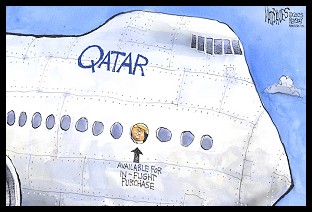 Sunday 'Now Hoarding' Toons
Sunday 'Now Hoarding' Toons Mad World:
Mad World: 'Green News Report' 5/15/25
'Green News Report' 5/15/25
 Plane Corruption and the Future of the DOJ: 'BradCast' 5/14/25
Plane Corruption and the Future of the DOJ: 'BradCast' 5/14/25 'Deeply Evil': GOP Proposes Largest Medicaid Cuts in History: 'BradCast' 5/13/25
'Deeply Evil': GOP Proposes Largest Medicaid Cuts in History: 'BradCast' 5/13/25 'Green News Report' 5/13/25
'Green News Report' 5/13/25 And Then They Came for the Mayors...: 'BradCast' 5/12/25
And Then They Came for the Mayors...: 'BradCast' 5/12/25 Sunday 'New Guy, Old Guy' Toons
Sunday 'New Guy, Old Guy' Toons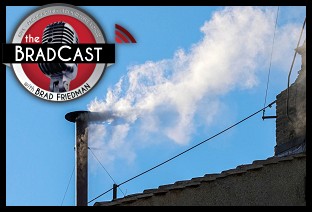 Blowing Smoke. At the Vatican and White House: 'BradCast' 5/8/25
Blowing Smoke. At the Vatican and White House: 'BradCast' 5/8/25 'Green News Report' 5/8/25
'Green News Report' 5/8/25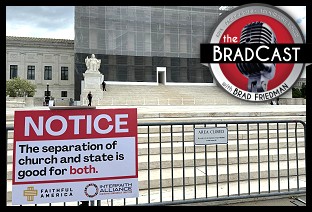 SCOTUS Weighs Public Funding of Religious Schools: 'BradCast' 5/7/25
SCOTUS Weighs Public Funding of Religious Schools: 'BradCast' 5/7/25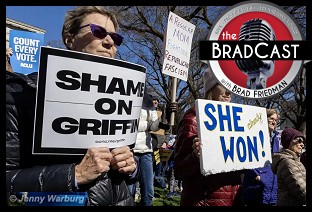 Trump Judge Blocks NC GOP Theft of 2024 Supreme Court Seat: 'BradCast' 5/6/25
Trump Judge Blocks NC GOP Theft of 2024 Supreme Court Seat: 'BradCast' 5/6/25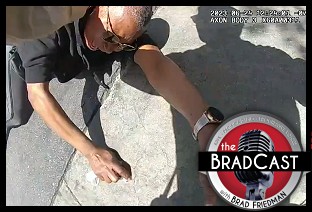 Prosecutors Quit After U.S Attny Strikes Deal With Felon Cop: 'BradCast' 5/5/25
Prosecutors Quit After U.S Attny Strikes Deal With Felon Cop: 'BradCast' 5/5/25 Trump Losing Streak Continues into SECOND Hundred Days: 'BradCast' 5/1/25
Trump Losing Streak Continues into SECOND Hundred Days: 'BradCast' 5/1/25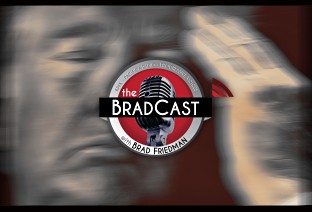 100 Daze (w/ Digby and Driftglass): 'BradCast' 4/30/25
100 Daze (w/ Digby and Driftglass): 'BradCast' 4/30/25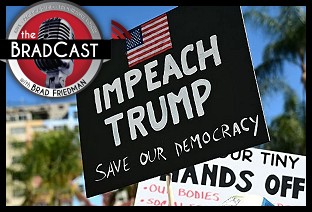 Campaign to 'Impeach Trump Again' Gains Fresh Momentum: 'BradCast' 4/29/25
Campaign to 'Impeach Trump Again' Gains Fresh Momentum: 'BradCast' 4/29/25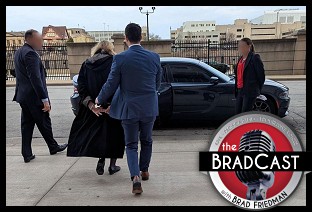 And Then They Came for the Judges...: 'BradCast' 4/28/25
And Then They Came for the Judges...: 'BradCast' 4/28/25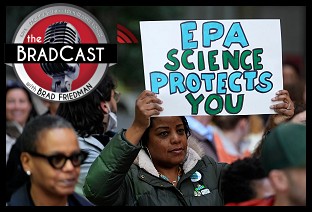 Trump EPA Guts Enviro Justice Office: 'BradCast' 4/24/25
Trump EPA Guts Enviro Justice Office: 'BradCast' 4/24/25
 VA GOP VOTER REG FRAUDSTER OFF HOOK
VA GOP VOTER REG FRAUDSTER OFF HOOK Criminal GOP Voter Registration Fraud Probe Expanding in VA
Criminal GOP Voter Registration Fraud Probe Expanding in VA DOJ PROBE SOUGHT AFTER VA ARREST
DOJ PROBE SOUGHT AFTER VA ARREST Arrest in VA: GOP Voter Reg Scandal Widens
Arrest in VA: GOP Voter Reg Scandal Widens ALL TOGETHER: ROVE, SPROUL, KOCHS, RNC
ALL TOGETHER: ROVE, SPROUL, KOCHS, RNC LATimes: RNC's 'Fired' Sproul Working for Repubs in 'as Many as 30 States'
LATimes: RNC's 'Fired' Sproul Working for Repubs in 'as Many as 30 States' 'Fired' Sproul Group 'Cloned', Still Working for Republicans in At Least 10 States
'Fired' Sproul Group 'Cloned', Still Working for Republicans in At Least 10 States FINALLY: FOX ON GOP REG FRAUD SCANDAL
FINALLY: FOX ON GOP REG FRAUD SCANDAL COLORADO FOLLOWS FLORIDA WITH GOP CRIMINAL INVESTIGATION
COLORADO FOLLOWS FLORIDA WITH GOP CRIMINAL INVESTIGATION CRIMINAL PROBE LAUNCHED INTO GOP VOTER REGISTRATION FRAUD SCANDAL IN FL
CRIMINAL PROBE LAUNCHED INTO GOP VOTER REGISTRATION FRAUD SCANDAL IN FL Brad Breaks PA Photo ID & GOP Registration Fraud Scandal News on Hartmann TV
Brad Breaks PA Photo ID & GOP Registration Fraud Scandal News on Hartmann TV  CAUGHT ON TAPE: COORDINATED NATIONWIDE GOP VOTER REG SCAM
CAUGHT ON TAPE: COORDINATED NATIONWIDE GOP VOTER REG SCAM CRIMINAL ELECTION FRAUD COMPLAINT FILED AGAINST GOP 'FRAUD' FIRM
CRIMINAL ELECTION FRAUD COMPLAINT FILED AGAINST GOP 'FRAUD' FIRM RICK SCOTT GETS ROLLED IN GOP REGISTRATION FRAUD SCANDAL
RICK SCOTT GETS ROLLED IN GOP REGISTRATION FRAUD SCANDAL VIDEO: Brad Breaks GOP Reg Fraud Scandal on Hartmann TV
VIDEO: Brad Breaks GOP Reg Fraud Scandal on Hartmann TV RNC FIRES NATIONAL VOTER REGISTRATION FIRM FOR FRAUD
RNC FIRES NATIONAL VOTER REGISTRATION FIRM FOR FRAUD EXCLUSIVE: Intvw w/ FL Official Who First Discovered GOP Reg Fraud
EXCLUSIVE: Intvw w/ FL Official Who First Discovered GOP Reg Fraud GOP REGISTRATION FRAUD FOUND IN FL
GOP REGISTRATION FRAUD FOUND IN FL

































